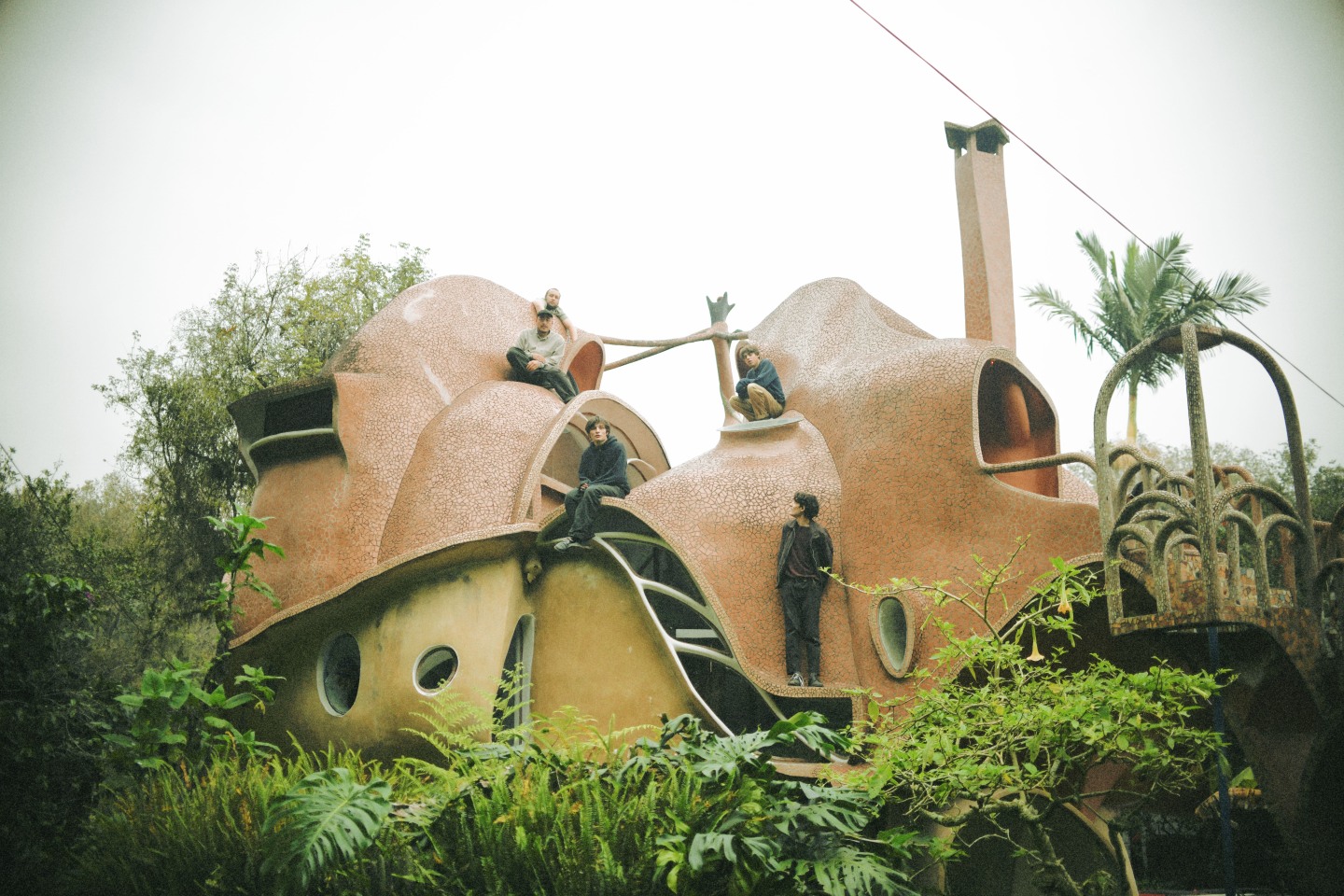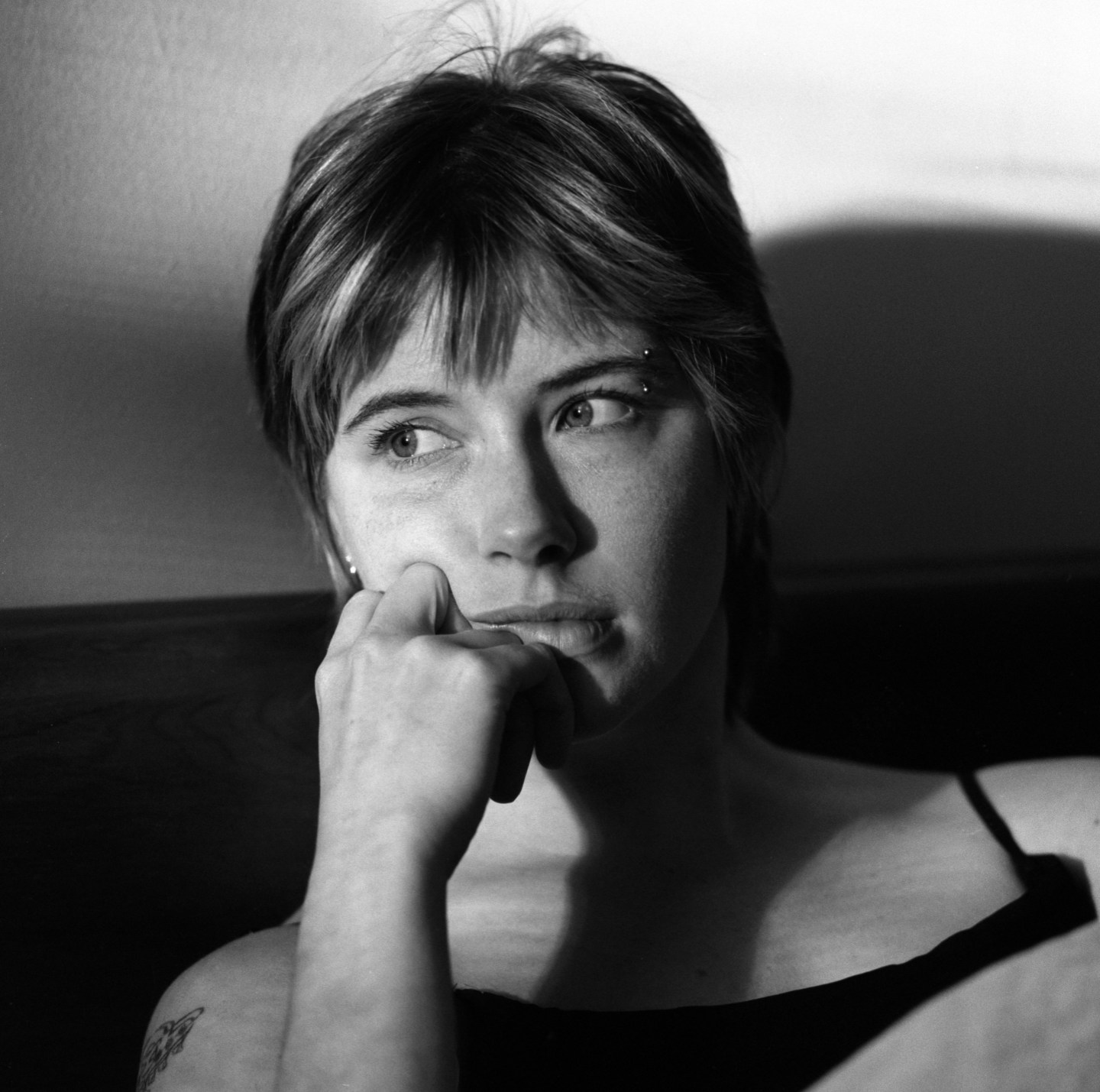Diles que no me maten. Photo by Melisa Lunar.
On a warm January night in Mexico City’s Santa María la Ribera neighborhood, I’m sitting on the floor of a studio space, listening to rough cuts from Diles que no me maten’s next album. Recording of the as-yet-unnamed LP wrapped the night before, so the songs are still fresh — almost too fresh — in the bandmembers’ minds. Before entering, I saw a friend of the band walk out in tears. “It’s intense,” she warned me.
Formed in 2017 by brothers Raúl and Gerardo Ponce (drums and guitar, respectively) and quickly expanding to include second guitarist Jéronimo García, bassist Andrés Lupone, and singer/saxophonist Jonás Derbéz — the CDMX-based five-piece started out as something of a metal band but quickly developed a language based on collective, repetitive improvisation. This led them to their first EP, Cayó de su Gloria el Diablo (The Devil Fell from Glory), a tryptic in which Derbéz delivers free-form, spoken-word poetry over boiling seas of krautrock psychedelia. The tape cemented the group as core members of a vibrant scene on the verge of bubbling over.
The upcoming project will be their fourth full-length, following three utterly distinct records: Their 2020 debut Edificio begins with a 12-minute improvisation over the contemplative chords of Bill Evans’s “Peace Piece”; 2021’s La vida de alguien más has a concise mid-album krautrock jam called “Outro”; and Obrigaggi, from 2023, strikes a difficult balance between free playing and discrete “songs.” In 2024, they collaborated with King Krule saxophonist Gal Go on a track called “27,” whose video premieres today via The FADER.
The new songs are indeed intense — crushing, jazz-tinged hyperballads with a few punchy, motorik rockers mixed in. After our impromptu listening session, we move to the roof of the building and are joined by Sebastián Rojas, a close friend of Diles who produced the album we’re listening to today. The band pour celebratory drinks and tell fast Spanish jokes I half understand. They regale me with stories about the notorious antics of Argentine rock legend Charlie Garcia, the inspiration for Russell Hammond’s epic pool dive in Almost Famous. As we settle in, the conversation steers itself into the tale of Diles que no me maten, their improv-based creative process, and their deep love for their city’s eclectic scene.
The FADER: Diles que no me maten (English: Tell them not to kill me), is named after a story by Juan Rulfo. I read that when you first thought of the name, none of you read the story, but everyone’s read it now. What did the name mean to you then, and what does it mean to you now?
Andrés Lupone: It’s really personal. For me, it feels like the experience of living here in this country because this is the country of a lot of murder and killing. Whether it’s the Aztecs or the government killing students, which still happens, it’s a reality. I feel that sentence [(“Diles que no me maten”)] still translates today.
Jonás Derbéz: He’s just writing as a normal guy from a little town. Then, suddenly, people in the city are reading [his work], and they think it’s magical, but it’s actually just the perception of the way [the characters] speak, the mixing of the regional language [(an interpretation of the Aztec language Nahuatl)] with Spanish, so it sometimes doesn’t make sense, which brings magic to the writing. For me, that’s the greatest thing about that story.
“People are paying more attention to our music, so we dare more to play quiet and low.”
You’ve said pretty much everything you do starts with improvisation. Can you describe how a typical improv session begins, and where it goes from there?
JD: When we improvise alone after too many days of not rehearsing, a lot of our feelings are communicated with each other. That’s what we did at the beginning to understand each other. When we started doing it live, it was to fit the stage and the crowd. When we play a house show, we improvise very differently when we play a crowded show with people screaming. Now it’s getting more and more similar; people are paying more attention to our music, so we dare more to play quiet and low.
So when you play live, do you mainly improvise, or do you play the songs through?
Gerardo Ponce: Both, actually. We make other versions of our songs, depending on the stage, depending on our mood. While we play, we pick the next song depending on how we’re feeling in the moment. We don’t have a set list.
Raúl Ponce: We usually talk [before the show] and say what songs we definitely want to play that night, and then we start improvising. If someone says, “I want to play this song” by playing the riff of that song, we’re like, “Okay, we can go with you, or we can ignore you.” We go on until more than two or three of us want to play that song.
JD: Sometimes we start to play one song and we sing another song.
I love your krautrock-leaning songs, and from what I understand, many of those legendary German bands worked the same way.
JD: It was a really nice way to make a band. We were learning how to play together, so we were playing the same chords, and that’s how we learned to communicate with each other.
AL: Maybe krautrock has been a constant thing because it’s a language we all understand, that we can communicate with.
Sebastián Rojas: There was one song we [recorded] was important for me. All the other songs are very composed, all overdubs and arranging. That’s the only song we recorded live, completely improvised. Whether the song comes out on the album, I don’t really care. But at that moment, you guys really connected. We were struggling with the process at the beginning, but everything started to work from there. It was as if it was a ritual you guys needed to get things going. That’s the beauty of that kind of music: It doesn’t require a cerebral thing in order to create a beautiful connection between musicians. It was something that needed to be done, and that you guys will probably do forever. Every time you need it, you have that tool you can get out of the box.
There was a song you played me that sounded like klezmer music to me. Andrés, you said you were going for a goth Duke Ellington vibe on that one. Can you expand on that?
AL: I was trying to make a Duke Ellington-type song on my computer, but it ended up really dark because I picked the lower-register saxophones, the baritone and tenor. We called Jonás’s father Alain, who’s a really accomplished and amazing musician and has been improvising for years, to play the tenor sax, but the tenor sax wasn’t working, so we were like, “Fuck it, let’s raise it an octave.” Because of that little detail, it sounds like klezmer. It wasn’t completely by the book as the score said, so the chords weren’t falling together at the same time. It was this sliding thing, and I told Alain, “Just improvise. Just do what you do.”
JD: For me, that one sounds like a funeral march. There’s a big tradition of music of this kind, mije music, in Oaxaca. [The song] reminds me of “Dios nunca muere,” a classic mije song that’s very beautiful. For me, this was like that but with improvisation. It’s like life rising up from the death march.
On another song you played me, “No me está rompiendo” — it’s not breaking me — is repeated over and over. Jonás, what does that lyric mean to you.
JD: It was about repeating “This is not going to break me” in a way that it sounds like it had completely broken me down. I say, “Even if I am completely broken, this is not gonna break me down.” The whole album is a little bit like that for me. I wanted to say something with the lyrics and have the music say the opposite.
“It’s like life rising up from the death march.”
Tell me more about the scene here in Mexico City.
JD: It’s in a really beautiful moment, really pure. The bands that I like are making music out of pure necessity. Every month, something is happening that’s really powerful. Even if you don’t like the band or the kind of music, you can tell it’s coming from a really specific and intimate place.
AL: It’s a really strong scene. Of course, every city has its scene and its local bands, but here, the scene is really spiritual. People are really devoted to going to shows and supporting the music, but also having an ongoing conversation with all of the music that bands are releasing. We’re all answering one another. It’s a really special time to be a musician in Mexico City. It’s not like all the hardcore punk bands are gathering with each other. You can be best friends with a dream pop band if you’re playing death metal and it won’t matter because we’re in the same spiritual place.
The show lineups that come from that must be really interesting.
SR: Every time. They’re very eclectic.
JD: At the beginning we were kind of a metal band in the worst way, and our first three shows had cumbia parties afterwards.
GP: We also had a show where the opener was a magician.
JD: He was my roommate.

Photo by Melisa Lunar.
Do you still play a lot of house shows?
JG: It’s not really a thing in Mexico like in the U.S. It’s difficult. We like [to play shows in] abandoned places.
What’s the best abandoned place you’ve played?
JD: It was in Tlatelolco, this huge project not far from here.
SR: It’s a conglomerate of 200 buildings made for [low-income housing], but it’s really beautiful.
JD: It’s kind of abandoned, but it’s recovering a bit, and they have a lot of public spaces, so a friend of ours did all the paperwork with the government so we could play there for free. We announced that we were gonna play in this garden the morning of the show, and a lot of people came. For me, that’s the most beautiful concert we’ve done.




